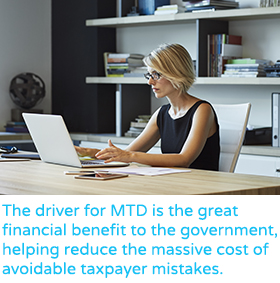The benefits to businesses are arguably greater. Anything that can help reduce the burden of managing and paying tax, is surely a winner. With MTD, companies can
- Detect mistakes as they happen
- More easily claim business expenses back
- Enjoy tax visibility throughout the year instead of year-end guess work
This article highlights the impact of the changes and suggests resources to help.
Background to Making Tax Digital
The HMRC's view is that, "Making Tax Digital will help bring the tax system into the 21st century by providing businesses with a modern, streamlined system to keep their tax records and provide information to HMRC."
Among all the positives, it's also worthwhile highlighting an element of caution expressed by some:
- ICAS offers cautious support in their comment here, "The long-term vision of Making Tax Digital (MTD) is attractive…….. However, this could be undermined by poor and rushed implementation"
- A report from the British Chambers of Commerce states that a quarter of businesses are not aware of MTD and two thirds are only partly aware
Feedback from businesses and other affected parties has brought about changes to the original proposals and timelines, to where we are now.
Key elements of the legislation
The second finance bill of 2017 requires that businesses above the VAT threshold must keep digital records of VAT from April 2019.
Businesses will not be asked to keep digital records or update HMRC quarterly for other taxes until at least April 2020.
Now there is a secondary legislation (SI 261/2018: The Value Added Tax (Amendment) Regulations 2018) to which all VAT eligible business must adhere. The key takeaway is that those businesses should digitally maintain and file their VAT returns within MTD "functionally compatible software," again from April 2019.
MTD compatible software
The (SI 261/2018) notice to which I referred above, includes a good explanation of this, as follows:
"Functional compatible software is a software program, or set of software programs, products or applications, that must be able to:
- record and preserve digital records (see paragraph 3.3)
- provide to HMRC information and returns from data held in those digital records by using the API platform
- receive information from HMRC via the API platform"
What does this digitisation mean for businesses?
The key takeaway from this is that businesses must ensure that their VAT records are digital. The storage of these records and the linking to the submission processes must be via approved software applications.
This means ensuring that the software you currently use is, or will be, compatible with the forthcoming VAT changes.
In summary
The HMRC is on a roll with these changes. It is keen to ensure that business taxation is efficient, and accurate to avoid losses to the state purse.
By April 2019, businesses need to be ready for the changes to the digitisation of VAT. Businesses should also be planning for the next wave of digitisation that will come.
Is your company fit and ready for taking advantage of the new growth opportunities that digitisation will bring? Watch this video with Constellation Research to learn how investing in technology can help prepare your company.
